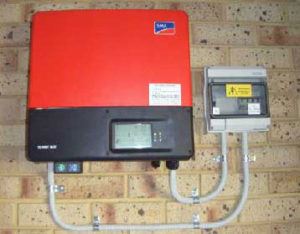If you’ve experienced an unexpected increase in your electricity bills or an unusual drop in energy output on your solar PV monitoring system, it’s time to look at the conditions of your system and possible factors that may be causing the drop. Causes can usually be narrowed down by first determining whether your solar system has a lower power output than it should or no power output at all and troubleshoot your solar yourself.
No Power Output
Inverter Failure
If your solar system has suddenly started to provide no power the most common cause of this is going to be an issue or failure with the inverter. Most solar inverters will have lights which will give you an indication whether something is wrong.

- Green = Inverter is operating as it should
- Blinking Green = Low amount of sunlight is on the panels
- No Color = No sunlight is on the panels (this is normal at night but if this is occurring on a sunny day it may be an indication there is an issue with your panels)
- Red/Orange/Yellow = Usually an error code
If your inverter is flashing a color which indicates an error or no color when it’s a perfectly sunny day, this is where you’ll want to speak to an installer and book an inspection to check whether you require a replacement inverter. If this is the case, make sure you check your warranty before forking out any unnecessary expensive.
Solar Panel Failure
A less common cause for no power being generated from your solar system may be a failing solar panel.
Good quality panels are built with an intended lifespan of 25+ years and will be able to withstand typical environmental factors like rain, wind and sun, however one defected panel can lower or wipe out an entire systems output if your system has a standard string setup. Those with micro-inverter system setups can usually rule this scenario out as a possible cause for no power output.
Again, in this case due to the cause being a damaged component of your solar system it is best to have a CEC Accredited Installer inspect your solar panels and determine a possible solution. Solar panels will usually come with a 25+ year warranty which you should be able to replace your faulty panel under.
Low Power Output
If your solar system is still working however providing a substantially lower output than usual or that your installer guaranteed it should, then there are a few possibly causes.
Weather

The first obvious one is a change in weather. If you’ve had your solar system for under 12 months and this is the first winter, overcast days or shorter sunlight hours you’ve experienced since installing, take that into account when looking over your systems drop in output. The less sunlight your panels receive, the less energy they are going to generate. If you think this may be the cause for your drop in output then there is no issue with your solar system, however you may want to change your energy habits with these “Maximise Your Solar Savings Tips†to assist in keeping your electricity bills low in winter.
Change In Environment
Shading may not have been an issue when first installing your solar panels however overtime trees do grow and with a solar system’s lifespan of 25+ years you may notice that things like branches from a tree or a neighbours second story extension may now be causing shade over your panels that it wasn’t before. Even if it is just one panel that is experiencing shade this can bring down the entire output of all the panels, if you have a standard string connected system. If a tree is the issue, simply trimming the branches back could have your solar system back to generating as much energy as before.
If shading over a panel has been caused due to factors that are not easily fixed you may want to consider micro-inverters to assist in optimising the panels that are not shaded.
Damage Due To External Factors
Without moving parts it’s unlikely a solar system’s components will wear out, however with a lifespan reaching 25 years + there are some external factors that may contribute to a systems sudden drop in output. These may include but are not limited to;
- System parts that are exposed filling with rain
- Animals (birds, rats) chewing or damaging cables
- Micro-cracks on your panels or damage from natural disasters, such as earthquakes, bushfires and storms
- Damage from home renovations
- Cables deteriorating overtime
- Components failing
If you’ve noticed the drop in output suddenly after a big storm, unusual weather or renovations it’s more than likely there has been some damage caused to your panels. How easily this can be fixed will require some expert advice from a CEC Accredited Installer.
Unsure If Your System Is Performing How It Should?
If you’re finding it hard to determine whether your solar system is producing as it should, use our simple test to assist in comparing your actual output against your systems recommended output.
Solar PV System Performance Test










